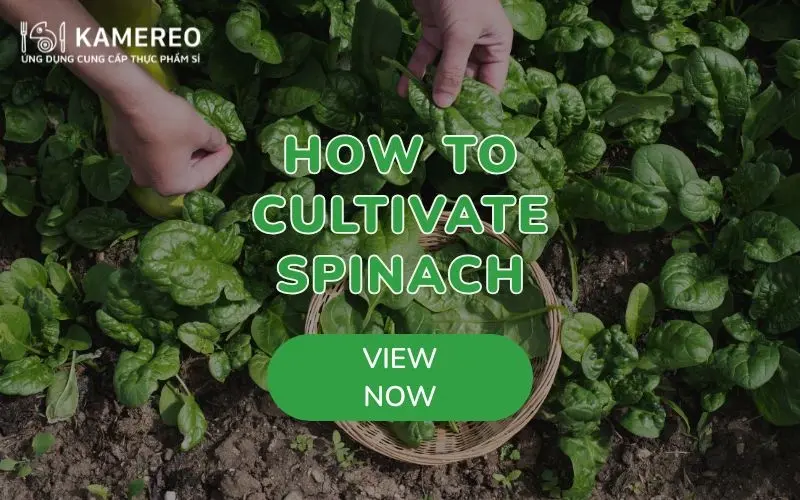Are you looking for an effective how to grow spinach at home? With just a few simple tools, a little time, and the right techniques, you can absolutely grow your own clean, fresh vegetables right in your living space. Let’s explore the detailed steps for simple and fast germination in the article below with Kamereo!
Preparation Before Planting Spinach
Before you start planting, thoroughly preparing the necessary elements will largely determine the success of your home spinach garden. Let’s find out what you need for optimal plant growth:
Choose the Right Time
The planting season is an extremely important factor, directly affecting the yield and quality of spinach. Spinach prefers cool, pleasant weather, so the ideal time for planting is usually in fall, winter, or early spring. More specifically, you can refer to the following timelines:
- Early season: From late September to early October.
- Main season: From October to November.
- Spring season: From January to early February.
- Winter-spring season: From December to early January.
In general, the period from September to February of the following year is the golden time to plant spinach, when the climate is most favorable for plant growth. However, if you live in an area with a cool climate year-round, you can freely plant spinach whenever you want.
Prepare Tools
To grow spinach effectively and cost-efficiently at home, you can utilize readily available items. Here are some suggestions for tools to prepare:
- Recycled items: Various foam boxes, large plastic bottles, old buckets, and basins at home can all be repurposed as planting pots.
- Specialized planting trays: If you want to make your garden more vibrant and aesthetically pleasing, you can purchase affordable planting trays such as rectangular trays, balcony hanging pots, or wall-mounted pots.
- Ensure drainage: Regardless of the type of container you choose, the most important thing is that all of them must have good drainage holes. This helps prevent waterlogging, protecting the root system and overall health of the plants.
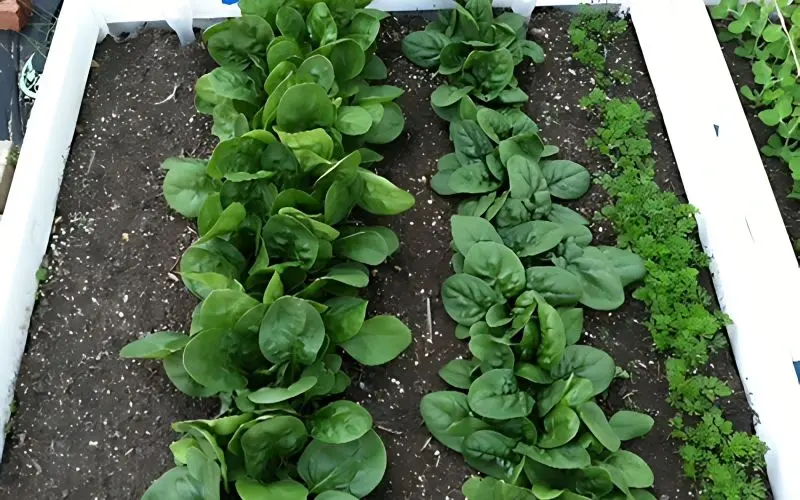
Prepare Potting Soil
Spinach prefers loose, humus-rich, moist soil that still ensures good drainage to prevent waterlogging and root rot. The ideal pH for vigorous spinach growth is between 6 and 8.
To enhance fertility and provide nutrients to the soil, you can mix in worm castings, coir, and other organic fertilizers. If you don’t have the conditions to mix your own, you can always buy pre-mixed potting soil sold in stores.
Choose Spinach Seeds
Currently, there are many spinach varieties on the market, such as small-leaf, large-leaf, straight-leaf, curly-leaf, etc.; you can choose according to your preferences or climate conditions. When buying, make sure the seeds are within their expiry date, the packaging is intact, and they have a clear origin to avoid buying low-quality or fake seeds.
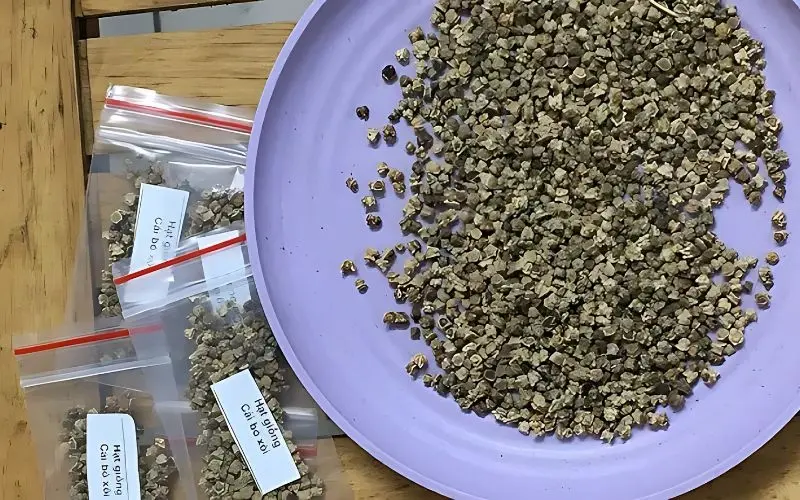
Prepare Fertilizer
For spinach to grow strong, you should prioritize using organic fertilizers such as:
- Worm castings
- Well-rotted manure (cow, goat, chicken)
- Organic microbial fertilizers
Additionally, you can also use NPK, nitrogen, phosphorus, and potassium fertilizers, but in appropriate and limited quantities to ensure the spinach is clean and safe for consumers’ health.
How to Grow Heat-Tolerant Spinach
Once all preparations are complete, it’s time to start the spinach planting steps. This process is quite simple but requires meticulousness for the seeds to germinate and develop into healthy seedlings:
Soak and Germinate Seeds
To help spinach seeds germinate quickly and increase success rates, soaking and germinating the seeds is an indispensable step.
- First, soak the seeds in warm water at about 40°C (mixed at a ratio of 2 parts boiling water to 3 parts cold water) for 3 to 4 hours. This temperature helps break the dormancy of the seeds.
- After soaking, remove the seeds, rinse them clean, and then germinate them in a damp cloth.
- Maintain the cloth’s moisture for about 8 hours, or until you see the seeds crack open and tiny roots emerge. At this point, the seeds are ready for planting.

Base Fertilization and Sowing Seeds
The soil needs to be base-fertilized and thoroughly prepared before sowing to create an ideal environment for seed germination:
- Add soil to the tray or pot, mix thoroughly with the prepared organic fertilizer.
- Level the soil surface, moisten slightly to increase soil adherence for the seeds.
Regarding sowing, you can choose one of the following two methods, depending on space and planting purpose:
- Method 1: Sparse sowing: Sow the soaked and germinated spinach seeds into the soil to a depth of about 6mm. Ensure a distance of 5cm between seeds to allow enough space for plant development. Afterward, lightly cover with soil and then shade the pot with straw or a shade net to maintain moisture, helping the seeds germinate quickly.
- Method 2: Dense sowing: Scatter the seeds evenly on the soil surface without paying too much attention to spacing. After sowing, place the pot in an area with moderate light to create suitable humidity, promoting the germination process.
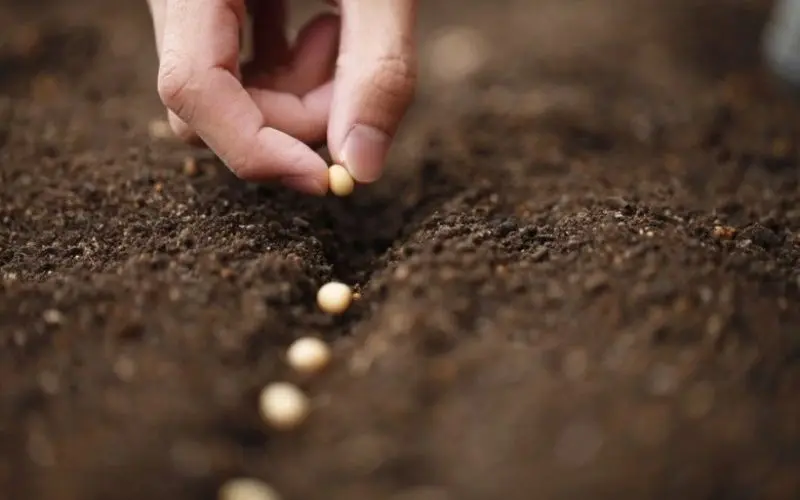
How to Care for Spinach When Growing
For spinach plants to grow healthy and yield high, proper care is a key factor. From watering and fertilizing to thinning and pest control, each step requires meticulousness and regularity.
Watering
Watering is one of the most important factors when caring for spinach, especially during the seedling stage:
- When first sowing seeds, you should water twice daily, in the early morning and late afternoon. Use watering cans with a gentle spray nozzle. This helps avoid washing away seeds or damaging weak, newly emerged sprouts.
- At the stage when the plants have grown larger and are developing strongly, you can adjust the watering frequency to once a day, depending on actual weather conditions. Avoid overwatering in the evening, especially letting the plants remain waterlogged overnight, as this can create favorable conditions for fungal diseases to attack and harm the plants.
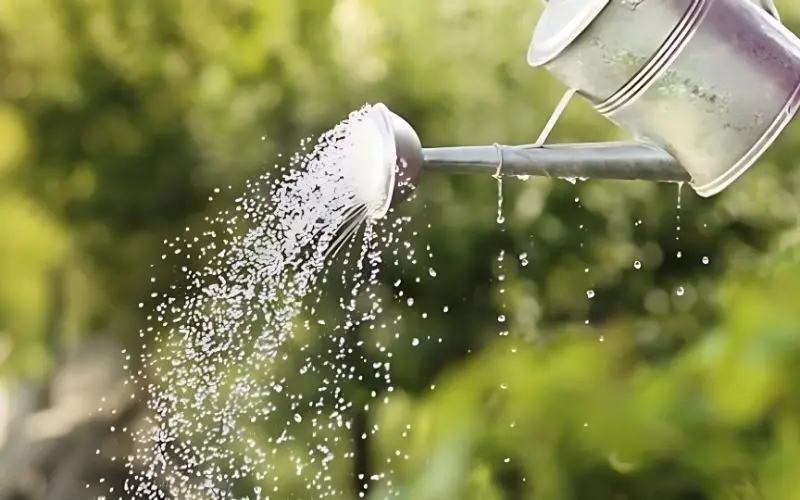
Fertilizing
Adding nutrients at the right time and in sufficient amounts will help spinach grow green and healthy, with plump young leaves:
- Approximately 10-12 days after sowing, you can start the first base fertilization. At this time, use worm castings combined with liquid organic foliar fertilizers such as fish emulsion, seaweed, or oilseed meal.
- About 10-15 days after the first fertilization, you can regularly supplement nutrients for the plants every 2 weeks with one of the following fertilizers: NPK 20-20-15 or DAP. For both types, mix 4 teaspoons into 1 liter of water and water the plants evenly.
Note: After top-dressing the plants, water again with clean water to wash off any fertilizer remaining on the leaves, preventing leaf burn. At the same time, regularly observe the growth rate and leaf color to adjust the frequency and dosage of fertilizer to suit the plant’s needs.
Thinning Leaves
When the seedlings are about 12-15 days old, it’s an appropriate time to thin them out. Remove weak, stunted, and poorly growing plants, and keep only the healthiest plant in each planting cell or at an appropriate distance. This helps concentrate nutrients for the remaining plants, ensuring they have enough space to develop a strong root system and lush foliage.
At the same time, you also need to regularly clean the planting area, weeding out all weeds around. Weeds not only compete with spinach for nutrients but also serve as ideal shelters for pests and diseases. Keeping the garden clean combined with timely pest prevention measures will help your spinach plants always be healthy and yield high.
Pest Control
Spinach plants, though easy to grow, can still be attacked by some common pests and diseases such as:
- Damping-off disease: This is a common disease in young vegetable plants, causing them to wilt and die at the base. To prevent it, you should mix Trichoderma fungus product into the potting soil to enhance beneficial microorganisms and inhibit pathogenic fungi. If plants are already infected, you can use suitable antifungal pesticides.
- Snails: These pests are very common and can destroy an entire tray of vegetables overnight; they particularly enjoy eating young shoots and leaves. To prevent them, you can set natural traps like watermelon rinds, orange peels, or honey. Or, for more convenience and speed, use specialized snail bait.
- Leaf miner flies on spinach: These are small, black adult flies that specifically harm leafy greens. To control them, you can place yellow sticky traps or insect traps around the planting area.
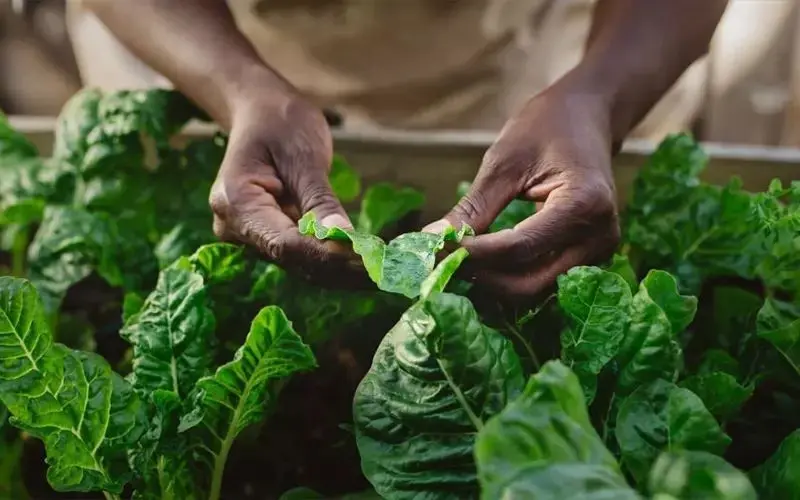
How to Grow Spinach from the Base
Growing spinach (spinach) from the base is a very simple and effective method to regenerate the plant without needing to buy new seeds. This is a great way to utilize the base of the vegetable that is often discarded, while also providing you with a continuous source of fresh vegetables right at home.
Preparation Steps
Before you begin, make sure you have the following items:
- Spinach base: Choose a fresh base that is intact and not bruised. You can use the base of spinach bought from a supermarket or market.
- Small bowl/dish or cup: To hold water for soaking the base.
- Clean water: Regular tap water is sufficient.
- Planting pot: The pot needs to have good drainage holes.
- Potting soil: The soil should be loose, rich in nutrients, and well-draining.

Implementation Steps
The process of growing spinach from the base is quite simple; with just a few basic steps, you can start your vegetable garden:
Step 1: Soak the spinach base in water
This is an important initial step to stimulate root and young shoot development.
- Cut the base: Cut the spinach base about 2-3 cm from the root part upwards.
- Place in water: Place the cut base in a small bowl or cup. Pour water until it covers about 1/2 to 2/3 of the vegetable base, ensuring the top part of the base is not submerged to avoid rot. Place the bowl/cup in a spot with indirect natural light, such as a windowsill. Avoid harsh direct sunlight.
- Change water: Change the water daily or every other day to ensure the water is always clean and prevent mold growth.
Step 2: Observe root and young shoot development
Over the next few days, you will start to see the first signs of life. Tiny roots will grow from the base, and from the center of the base, tender green leaf sprouts will emerge. This process usually happens quite quickly, taking only about 3-7 days, depending on environmental conditions and the freshness of the spinach base.
Step 3: Plant in soil
When the roots have reached a length of about 1-2 cm and the leaf sprouts have developed clearly, your spinach base is ready to be transferred to a soil environment.
- Prepare the pot: Pour the prepared potting soil into the pot, gently pressing it down to stabilize the soil.
- Plant the seedling: Create a small hole in the center of the pot, then place the spinach base so that the entire root system is completely buried in the soil and the leaf sprouts emerge above the soil surface.
- Water: Water gently to moisten the soil, helping the soil cling to the roots and allowing the plant to easily adapt to the new environment.
Step 4: Care
Once planted in soil, proper care will help the spinach plant grow vigorously and yield regularly.
- Light: Place the pot in a location with full or partial sunlight. Spinach grows best in conditions with sufficient light (at least 6 hours of sunlight per day).
- Watering: Always keep the soil moist but not waterlogged. Water when the topsoil begins to dry out.
- Fertilizing (optional): About 2-3 weeks after planting, you can add diluted organic fertilizer to provide additional nutrients, helping the plant grow better.
- Harvesting: When the leaves are large enough, you can start harvesting by cutting the outer leaves, leaving the young leaves in the center. This will encourage the plant to continue growing and give you multiple harvests.
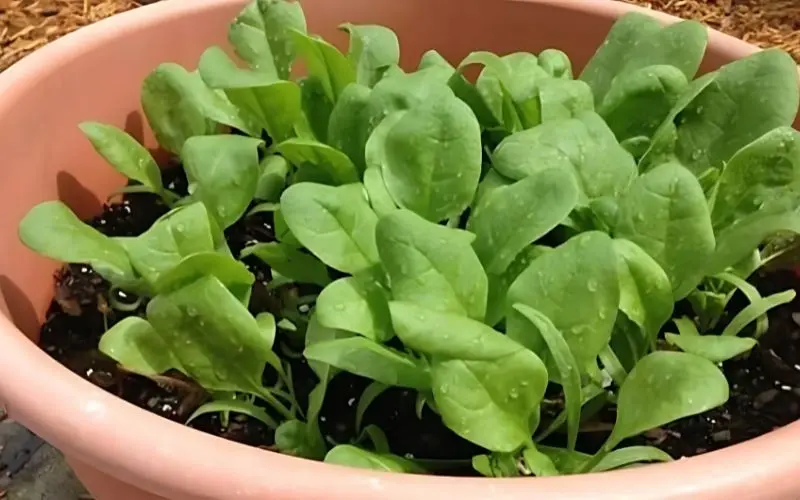
Buy Fresh, Good Price Spinach with Full VAT Invoices at Kamereo
Kamereo is a supplier of fresh spinach and agricultural products, harvested fresh daily, specializing in serving F&B businesses. We cooperate directly with farms in Da Lat – where the clean climate and fertile soil create ideal conditions for growing lush green, tender, crisp, and nutritious spinach. From planting to harvesting, each row of vegetables is meticulously cared for by dedicated farmers, ensuring the freshness for every meal.
Buy fresh, good price spinach with full invoices at Kamereo:
Error fetching data
All spinach after harvesting is transported by Kamereo in refrigerated trucks, stored in specialized cold storage, and undergoes multiple quality control checks from the farm, purchasing center, distribution warehouse, all the way to the customer. As a result, F&B businesses always receive ingredients that are consistently standard in size, weight, and quality, ready to serve diners nutritious and appealing dishes.
In addition to providing quality products, Kamereo also pioneers the application of technology throughout the entire food supply chain. With a modern ordering platform on our website and mobile app, businesses can easily search for and order spinach along with over 3,000 other products anytime, anywhere. The system also supports managing multiple branches, approving orders, controlling costs, and generating detailed statistical reports to optimize operations and budget transparency.
With a commitment to delivering correctly, completely, and on time, Kamereo helps F&B businesses always feel secure about their input ingredients. Furthermore, our flexible return policy and automatic electronic invoice generation help businesses control their finances more easily, accurately, and quickly than ever before.
Kamereo is not just a spinach supplier; we are a strategic partner accompanying F&B businesses on their sustainable development journey.

Frequently Asked Questions
Can spinach be grown in summer?
Although spinach prefers cool weather and is generally not recommended for planting in summer or in hot southern regions, many heat-tolerant spinach varieties have now been bred. Therefore, if the weather is not too scorching, you can certainly try growing spinach in the summer. For areas with cool climates year-round, growing spinach all year round is entirely feasible.
How long does it take for spinach to be harvested?
For plants grown from seedlings, you can start harvesting after approximately 35-40 days from planting. Meanwhile, if you sow seeds directly, the harvest time will be slightly later, around 50-60 days after sowing.
Which month should spinach be planted?
The ideal time to plant spinach is from September to February of the following year. More specifically, you can sow early season from late September to early October, main season from October to November, spring season from January to early February, and winter-spring season from December to early January.
Conclusion
With the detailed and effective guide on how to grow spinach easily above, we hope you have grasped the secret to creating lush green vegetable beds right at home. Growing your own vegetables not only provides a source of clean, safe food for your family but also offers an enjoyable and relaxing gardening experience. Additionally, don’t forget to follow Kamereo’s Food and Lifestyle section to discover more great gardening tips and choose quality food every day!
See more:



